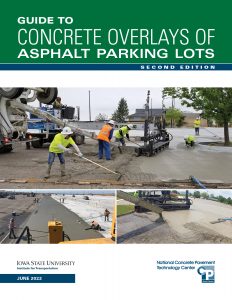InTrans / Jun 02, 2022
CP Tech Center publishes Guide to Concrete Overlays of Asphalt Parking Lots

Placement using a laser-guided screed (Michael Hoeft, K & M Concrete Construction, Inc., used with permission)
Many important factors considered for concrete overlays of asphalt pavements apply to overlays placed on both roadways and parking lots. However, some characteristics and considerations unique to parking lot overlays affect their design and construction—including fixed elevation points, traffic types and levels, and future changes in usage.
To address these types of overlay applications, the National Concrete Pavement Technology Center (CP Tech Center) recently published the second edition of its Guide to Concrete Overlays of Asphalt Parking Lots, a companion document to the fourth edition of the Guide to Concrete Overlays released last year.
The guide provides information for decision-makers and practitioners about selecting, designing, and constructing successful concrete overlays on existing asphalt parking lot pavements that serve public, commercial, or multifamily residential buildings.
“Parking lot owners stand to benefit from the proactive, sustainable, long-lasting, and economical strategies for pavement preservation and rehabilitation that concrete overlays represent,” said Gordon Smith, CP Tech Center associate director and lead author of the guide. “With a properly designed and constructed concrete overlay, a distressed or poorly performing asphalt parking lot can be converted into a durable, low-maintenance, and long-life parking structure.”
The updated material in the second edition of the guide reflects advances in technology and research, offers a simplified approach to assessing existing pavements, includes modifications to the material on design and construction based on lessons learned, and presents project profiles demonstrating the principles of the guide.
Though the guide focuses on parking areas that carry and store light vehicles (primarily automobiles and pickup trucks), it also addresses adjacent access roads and truck lanes that regularly carry heavy trucks for the delivery and pickup of goods and materials, including solid waste containers.
“This document offers expert guidance to supplement practitioners’ own professional experience and judgment,” said Jerod Gross, Snyder & Associates, Inc. project manager and an author of the guide. “With this information, parking lot owners can confidently include concrete overlays in their toolbox of asphalt parking lot maintenance solutions and make informed decisions about overlay design and construction based on existing asphalt conditions. “
The guide update was sponsored by the Ready Mixed Concrete Research & Education Foundation, and the National Ready Mixed Concrete Association (NRMCA) aided the authors in identifying necessary updates based on advancements in technology as well as relevant research.
The updated Guide to Concrete Overlays of Asphalt Parking Lots and the fourth edition of the Guide to Concrete Overlays are both available, along with other documents related to concrete overlays, at https://cptechcenter.org/.
